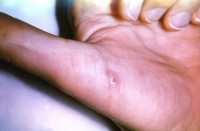
09 Dec Vector-Borne Bartonella Organisms Associated with Skin and Neuropsychiatric Symptoms
MedicalResearch.com Interview with:

Dr. Breitschwerdt
Ed Breitschwerdt, DVM, DACVIM
The Melanie S. Steele Distinguished Professorship in Medicine
Professor, Internal Medicine
NC State College of Veterinary Medicine
MedicalResearch.com: What is the background for this study?
Response: Bartonella species represent a medically underappreciated group of vector-transmitted bacteria that are increasingly implicated in a spectrum of animal and human diseases. Most recently, our research group has focused on the potential role of these bacteria as a cause or co-factor in patients with neuropsychiatric symptoms. This focus is based upon prior case reports and case series generated by our research group and others.
MedicalResearch.com: What are the main findings?
Response: The most important finding is that Bartonella species DNA, indicative of “active” or ongoing infection, was found in the blood of a substantial number of patients with neuropsychiatric symptoms. This finding provides a potentially new avenue for treatment interventions, as we previously reported in a case of a young boy with Pediatric Onset Neuropsychiatric Syndrome or PANS. In that 2019 case report, therapy directed at eliminating the Bartonella infection resulted in complete resolution of neuorpsychatric symptoms, which had not resolved with prior treatments during a sixteen month time frame.

“The right hand of this patient displayed a lesion on the thenar eminence, that was caused by the scratch of a cat, resulting in the patient acquiring a cat-scratch fever infection. This illness is caused by the bacterium, Bartonella henselae.
CDC/ Dr. Sellers, Grady Hospital”
The second most important finding is that many of these individuals reported the concurrent development of skin (cutaneous) lesions and neuropsychiatric symptoms. Bartonella species are most often transmitted by a vectors, such as a fleas, lice, sand flies, ticks and likely others insects for which vector competence has not been demonstrated by laboratory studies. As described in the manuscript discussion, there is precedent for other vector borne organisms to cause both cutaneous lesions and neurological symptoms. Another important mode of transmission is animal bites and scratches.
MedicalResearch.com: What should readers take away from your report?
Response: If an individual develops cutaneous lesions and neuropsychiatric symptoms within a similar time frame, neurologists, psychiatrists and dermatologists should review the medical history for vector exposures and animal bites or scratches. If these risk factors are identified, testing for Bartonella spp. infection would be indicated.
MedicalResearch.com: What recommendations do you have for future research as a result of this study?
Response: There is a very clear need for research to expand upon the prevalence of Bartonella spp. blood borne infection among various neuropsychiatric patient populations in various geographic locations throughout the world. Clearly, the cat flea (Ctenocephalides felis) has a world wide distribution and is the primary vector for Bartonella henselae and Bartonella koehlerae, the two Bartonella species identified in participants in our study. Also, basic science studies that will begin to elucidate potential interactions between this genus of bacteria and central nervous system dysfunction are needed. Most importantly for patients, highly structured, controlled treatment trails of individuals with microbiologically proven blood borne infection, using highly sensitive techniques as reported in our study, are needed to determine if therapeutic antimicrobial interventions might improve or eliminate neuropsychiatric symptoms and the accompanying cutaneous lesions.
MedicalResearch.com: Is there anything else you would like to add? Any disclosures?
Response: Recently published evidence indicates that Bartonella spp. infected animals and humans 4000 and 2000 years ago, respectively; however, Bartonelloses are only recently recognized as a cause of emerging infectious diseases primarily involving the cardiovascular, nervous, musculoskeletal systems. It is possible that we should add the cutaneous system that covers our bodies and communicates with insect vectors to the list of organ systems in which Bartonella spp. can induce pathology.
The following disclosure was included in this and all manuscripts from our research group:
Conflicts of Interest: In conjunction with S. Sontakke and North Carolina State University, Edward B. Breitschwerdt holds US Patent No. 7115385: Media and Methods for Cultivation of Microorganisms, which was issued on 3 October 2006. He is a co-founder, shareholder, and Chief Scientific O
fficer for Galaxy Diagnostics, a company that provides advanced diagnostic testing for the detection of Bartonella spp. infections. R. Maggi is the Chief Technical Officer for Galaxy Diagnostics. The remaining authors declare no conflicts of interest. The funders had no role in the design of the study; in the collection, analyses, or data interpretation; in the writing of the manuscript; or in the decision to publish the results.
Citation:
“Bartonella Associated Cutaneous Lesions (BACL) in People with Neuropsychiatric Symptoms”
Authors: Ed Breitschwerdt, Julie Bradley, Ricardo Maggi, Erin Lashnits, North Carolina State University; Paul Reicherter, University of Missouri Kansas City
Published: Online Dec. 7, 2020 in Pathogens
The information on MedicalResearch.com is provided for educational purposes only, and is in no way intended to diagnose, cure, or treat any medical or other condition. Always seek the advice of your physician or other qualified health and ask your doctor any questions you may have regarding a medical condition. In addition to all other limitations and disclaimers in this agreement, service provider and its third party providers disclaim any liability or loss in connection with the content provided on this website.
Last Updated on December 9, 2020 by Marie Benz MD FAAD
